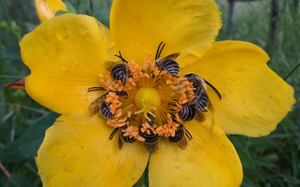Seven bee-friendly fruits and veggies
 Bees pollinate a third of what we eat and play a vital role in sustaining the planet’s ecosystems. Some 84% of the crops grown for human consumption need bees or other insects to pollinate them to increase their yields and quality. Bee pollination not only results in a higher number of fruits, berries or seeds, it may also give a better quality of produce.
Bees pollinate a third of what we eat and play a vital role in sustaining the planet’s ecosystems. Some 84% of the crops grown for human consumption need bees or other insects to pollinate them to increase their yields and quality. Bee pollination not only results in a higher number of fruits, berries or seeds, it may also give a better quality of produce.
Whether you are a bee boffin or simply a bee lover, here are seven fruits and veggies that get ‘a buzz’ from bee pollination
Almonds – They're a waistline-friendly snack and loaded with enough health benefits to land them a coveted spot in our list. The almond crop is very much dependant on honeybee pollination.
Research has shown that a lack of bees and other wild insects to pollinate almonds can reduce harvest yields more drastically than a lack of fertilizer or a failure to provide the crops with sufficient water. When almonds are adequately pollinated, the trees bear more fruit and their nutrient content changes, with increases in Vitamin E.
Apples – China is the world’s largest apple producer followed by the United States of America, Turkey, Italy and France. Raw or in an apple pie, without bees the cross-pollination needed to produce apples may not happen on a scale large enough to satiate today’s demand.
Usually, hives should be introduced when approximately 5% of the blossom is already in evidence to encourage bees to start working right away. A stocking rate of 2–3 hives/ha has been stated to be adequate for pollinating apples. An apple flower may need four or five bee visits to receive enough pollen grains for complete fertilisation.
Blueberries – The United States of America is the world’s largest producer of blueberries, harvesting a total of 132k tonnes of cultivated and wild blueberries in 2013.
Bumblebees visit more flowers per minute than other pollinators, and have no difficulty extracting nectar from blueberry flowers with their long tongues. This is important because the corolla of the blueberry flower is bell-shaped. Nectar is secreted at the base of the style, requiring an insect to push its tongue between the filaments of the anthers to reach it.
Cucumbers –They are a popular option for cooling down in hot summer months. Their cool, fresh flavor and crunchy bite make them a popular addition to salads, sandwiches and also drinks. Without bees, the majority of yields would be nonexistent.
Yield increase of up to 40% in cucumber in green houses have been obtained by putting five beehives with about 12 500 bees for every 1/15 ha. It is recommended that the beehive bed be kept at the level of the top of vegetables. There should also be sufficient space for bees to move around. Put water in plates at the ground between vegetables for bees to drink from.
Onions – If you’ve ever seen bees pollinating an onion umbel (the flowering head), they are a joy to watch.
Honey bees will visit onion flowers to collect both nectar and pollen, but only nectar foragers will visit both male-sterile and male-fertile lines in hybrid onion production. Usually, bees do not find onions very attractive so high colonies, of 30 hives or more, have a better chance of success.
Pumpkins – From Jack-o'-lanterns to the Chilean Beef and Pumpkin stew (Cazuela de Vaca), the world would be missing out on many delicious pumpkin based dishes and traditions.
Tillage practices that create special soil cover conditions can influence pollinator abundance. In general, pumpkin pollinators are ground-nesting bees. The female bee collects pollen and nectar from cucurbit flowers (like squash and pumpkins). They are active very early in the morning with activity diminishing by midmorning.
Strawberries – A perfectly ripened strawberry is a cosmic and nostalgic experience. A strawberry’s zing, flavor complexity and sweetness are mostly due to pollination.
A fully developed strawberry needs about 21 visits from bees. A single strawberry, can have 400-500 seeds (or small nuts) sitting on the surface of one berry. The higher the number of fully developed seeds, the bigger, tastier and even shaped a strawberry gets.
For more information FAO

